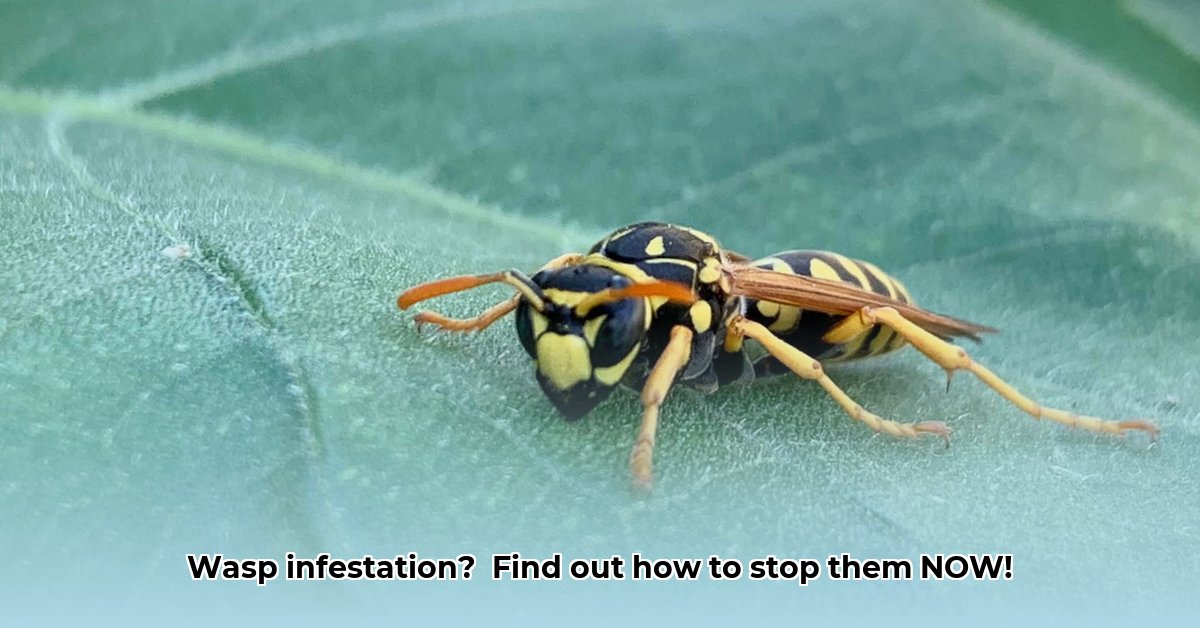Summer gatherings can quickly be disrupted by wasps. Understanding what attracts these insects is crucial for effective control. This guide provides easy-to-follow steps to eliminate wasps and enjoy your outdoor spaces. We will explore their food preferences and nesting habits, offering practical solutions for a wasp-free home. Let’s explore wasp attractants, seasonal strategies, and effective control methods. For information on other flying pests, check out this guide on common pest attractants.
Understanding Wasp Attraction and Behavior
Knowing what draws wasps to your property is the first step in keeping them away. Unlike bees, wasps boast opportunistic and varied appetites, and understanding this diverse appetite is key to effective Wasp Control. Their tastes change with the seasons, and knowing this is key to ensuring that you have the upper hand in keeping them away from your home. What are the key things that attract wasps year-round?
- Varied Diet: Wasps consume proteins during spring and summer and switch to sweets in the fall.
- Water Sources: They need water, so puddles, leaky faucets, or birdbaths can attract them.
- Shelter for Nesting: Cracks in siding, gaps under eaves, and holes in walls provide nesting sites.
- Decaying Organic Matter: Wasps are also drawn to the smell of decay and garbage.
A Wasp’s Changing Menu: From Protein to Pâtisserie
In spring and summer, wasps hunt for protein to feed their young. Juicy barbecue scraps, overripe fruit, or pet food attract them to outdoor gatherings. In the fall, as protein needs decrease, wasps crave sweets. Overripe plums, sugary soda spills, and ice cream residue become irresistible. This seasonal shift dictates effective wasp management. Understanding their diet is at the core of wasp prevention, and proper pest management starts with understanding the basic habits of the wasp.
Beyond the Buffet: Water, Shelter, and Nest Building
Wasps need water to survive, and a small puddle or birdbath can become a popular watering hole. They also seek shelter for building nests in cracks in house siding, gaps under eaves, and holes in walls. Knowing these nesting preferences can help prevent wasp infestations.
Seasonal Strategies: Adapting to the Wasp’s Shifting Desires
The best wasp control depends on the season. In spring and summer, focus on removing outdoor food sources. In autumn, use sugary syrup as bait in traps. This isn’t just using the right kind of bait, it is also using the right kind of bait at the right time. Understanding their changing needs will prove to be essential to keeping them at bay.
A Step-by-Step Plan to Manage Wasp Activity
Effectively managing wasps requires a multi-pronged strategy. Here’s a practical guide:
- Clean Up: Clean up spills, especially sugary drinks and food leftovers. Secure garbage bins tightly and remove fallen fruit regularly. Think of it as preparing for a very picky guest.
- Water Management: Fix leaky pipes and hoses promptly. Cover birdbaths during peak wasp activity times.
- Seal Gaps: Inspect your home’s exterior for cracks and openings where wasps might nest. Caulk eaves, window frames, and siding gaps.
- Smart Trapping: Use commercial wasp traps with meat-based lures in spring/summer and sugary bait in the fall. Regularly check and replace traps.
- Natural Deterrents: While plants like peppermint and lemongrass may repel wasps, they are temporary solutions – and proper pest control will require more than just these natural solutions.
- Call Professionals: Contact a pest control professional for established nests or large infestations. DIY solutions can be unsafe, especially with large nests. Pest control professionals have the tools and expertise to ensure that the wasps around your home are properly taken care of.
Weighing Your Options: Pros and Cons of Different Methods
Here’s a comparison to help you decide what approach suits your circumstances best:
| Method | Pros | Cons |
|---|---|---|
| Eliminating Food Sources | Simple, inexpensive, prevents initial attraction | Requires consistent effort, doesn’t remove existing nests |
| Trapping | Effective in reducing numbers, relatively easy to implement | Doesn’t eliminate entire colonies, requires monitoring and maintenance |
| Sealing Entry Points | Prevents future infestations, a long-term solution | Requires careful inspection and may not be feasible for all entry points |
| Professional Pest Control | Safe, thorough, fast action, best for large or hard-to-reach nests | More expensive |
| Natural Repellents (plants) | Relatively cheap, easy to implement | Effectiveness varies, mainly a short-term deterrent, not suited for large nests |
Safety is paramount. Never attempt to remove a wasp nest yourself unless experienced. If unsure, always call a professional. It’s better to be safe than sorry!
How to Choose the Best Wasp Trap Bait for Different Seasons
Understanding the dietary habits of wasps, especially the seasonal shifts, is critical to effective wasp trapping, ensuring you’re using the most attractive bait at the right time. This knowledge enhances the success of your trapping efforts.
Key Takeaways:
- Wasp diets shift with the seasons, impacting bait effectiveness.
- Protein lures (meat, fish) work best in spring.
- Sugary attractants (fruit juices, soda) are better in summer and fall.
- Adding dish soap boosts trap efficacy.
- Trap placement and maintenance are essential.
Springtime Strategies: Protein Power
Spring is about building nests and raising broods. Wasps need protein to fuel this activity. Therefore, a protein-rich bait is best, such as small pieces of raw meat, fish scraps, or pet food. These protein sources are irresistible to hungry wasps.
Summertime Solutions: Sweet Success
Summer brings a change in wasp behavior. They focus on foraging for energy. A switch to sugary baits is in order. Use sugary drinks like soda or fruit juice, or even sweet jams and jellies. These sugary lures are highly effective during this high-energy period. Understanding their diet is at the core of all wasp prevention.
Autumnal Allure: A Final Feast
As autumn arrives, wasps seek a last burst of energy before winter. Sugary baits remain effective. Focus on overripe fruits or a sweet combination of sugar and water to capture these late-season pests.
The Dish Soap Secret: A Drowning Aid
No matter the bait, adding a few drops of dish soap makes a difference. The soap reduces surface tension, preventing wasps from escaping and dramatically enhancing the trap’s effectiveness.
Trap Placement and Maintenance: Key to Success
Strategic placement is vital. Place traps where wasps are frequently sighted, such as near garbage cans or outdoor eating areas. Regularly check and empty your traps; a full trap stops attracting new wasps. Consistent maintenance is essential for achieving maximum results.
Bait Options: A Comparison Table
| Season | Best Bait Type | Pros | Cons |
|---|---|---|---|
| Spring | Protein (meat, fish, pet food) | Highly attractive to nesting wasps | May attract unwanted scavengers; can spoil quickly |
| Summer/Fall | Sugary (soda, juice, jams) | Highly attractive to foraging wasps | Can attract bees; may attract ants |
Wasp Control Strategies for Suburban Gardens
Key Takeaways:
- Wasps are drawn to food sources like sugary drinks, ripe fruit, and protein. They also need water and suitable nesting sites.
- Effective Wasp Control Strategies for Suburban Gardens involve removing attractants and using repellents.
- Natural repellents, like peppermint oil and clove, can deter wasps. Commercial traps are another option.
- Preventing wasp nests is key. Seal gaps in your home and trim overgrown vegetation.
Understanding What Attracts Wasps
Wasps seek resources: food, water, and shelter. Sweet substances like soda, overripe fruit, and sugary flower nectar are irresistible. Protein sources, such as leftover meat, are equally attractive. Water is crucial, and untreated wood is a favorite nesting material.
Effective Wasp Repellents
Natural repellents like peppermint oil, clove oil, and eucalyptus are disliked by wasps. Place bowls of these oils around your garden. Remember scents that attract humans, like perfumes, also attract wasps. Regularly check and clean up your garden, and properly maintain the spaces wasps may use to build nests. Additionally, consider planting wasp-repelling plants like citronella, marigolds, and wormwood around your garden perimeter for a natural defense.
Preventing Wasp Nests: A Proactive Approach
The best defense is prevention. Seal any cracks or gaps in your home’s exterior using caulk or expandable foam. Pay special attention to areas where pipes or wires enter the house. Trim back overhanging branches and vegetation to eliminate potential nesting sites close to your home. Keep garbage cans covered and clean up spills promptly to reduce wasp encounters. Consider using mesh netting to protect fruit trees and berry bushes from wasps and other pests.
A Comparison of Control Methods
| Method | Pros | Cons |
|---|---|---|
| Natural Repellents | Safe, environmentally friendly, relatively inexpensive | Effectiveness can vary; may require frequent reapplication |
| Commercial Traps |
- Why an App Appeared on My Phone Unexpectedly - November 22, 2025
- How to Stop Unwanted Apps from Automatically Downloading on Android - November 21, 2025
- Why Are Android Games Installing Themselves on Your Phone? - November 20, 2025










